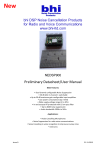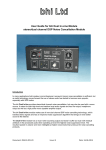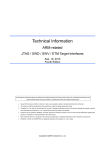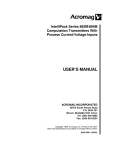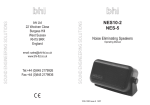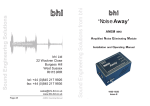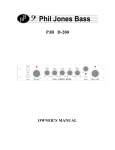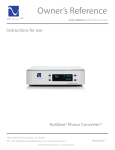Download Preliminary Datasheet/User Manual
Transcript
New bhi DSP Noise Cancellation Products for Radio and Voice Communications www.bhi-ltd.com NEDSP900 Preliminary Datasheet/User Manual Main Features: • Dual channel configurable Noise Suppression • 30 dB AGC in channel 1 switchable • Up to 30 dB maximum gain configurable input amplifiers • Low power consumption (typ <5mA) • Wide supply voltage range (3 to 20V) • In‐and outputs RF protected with LC low pass filter • Up to 40dB noise suppression • Audio bandwidth 300Hz to 5KHz Applications: • Noise Cancelling Microphones • Noise Suppression for radio voice communications • Noise Cancelling in voice recognition to improve accuracy rates • Intercoms Issue:3 21‐11‐2013 NEDSP900 User Manual 1. Introduction The NEDSP900 is a dual channel audio Noise Suppression pcb module capable of handling a wide range of audio inputs and providing up to 40dB of noise suppression. The module operates on a single supply rain with on‐board voltage regulation and clock oscillator. It has low power consumption which makes it suitable for portable applications. The noise suppression is carried out using a Digital Signal Processing (DSP) device that runs software containing a CNS Noise Suppression algorithm. This is patented technology for noise reduction of speech signals. It is known as one of the best algorithms of its kind and is ideally suited for real‐time processing in any kind of voice communication system in noisy environments, such as handsfree telephone sets, industrial intercom systems and radio communication systems. 2. Module Outline The module comprises a multi‐layer PCB that provides good signal isolation and grounding making integration into target systems easy with the minimum of design effort. A few simple rules need to be observed in order to preserve the achievable levels of noise suppression, these are dealt with later in this document. Pins are on a 2mm pitch. Fig 1: View looking down on top of module showing basic dimensions and pin designations 2 Issue: 3 NEDSP900 User Manual 3. Pin Designations (see fig1) From the annotated module outline fig1 on the previous page, the pattern of the pin‐outs provides the user with good signal separation that can be continued easily on any board designed to carry the analogue and digital interface electronics. Pin Designation Function Use 1 +ve Supply Positive supply input +5V to +20V supply 2 GND Ground ‐ Power Associated with Supply 3 Cnl 1 NS On/Off Channel 1 Noise Suppression On/Off Internal Pull Up 4 Cnl 1 NSL Bit 2 Channel 1 Noise Suppression Level control Bit 2 Internal Pull Up 5 Cnl 1 Gain Bit 0 Channel 1 Input Gain control Bit 0 Internal Pull Up 6 GND Ground –use for Analogue/Digital Isolation 7 Audio 1 Out Channel 1 Audio Output DC Isolated 8 Audio 2 Out Channel 2 Audio Output DC Isolated 9 GND Ground – for use with Audio I/O Isolation 10 GND Ground – for use with Audio I/O Isolation 11 Audio 1 In Channel 1 Audio Input DC Isolated 12 GND Ground – for use with Audio Inputs 13 Audio 2 In Channel 2 Audio Input DC Isolated 14 GND Ground associated with Control Signals 15 Cnl 1 Gain Bit 1 Channel 1 Input Gain control Bit 1 Internal Pull Up 16 Cnl 1 Gain Bit 2 Channel 1 Input Gain control Bit 2 Internal Pull Up 17 Cnl 2 Gain Bit 0 Channel 2 Input Gain control Bit 0 Internal Pull Up 18 Cnl 2 Gain Bit 1 Channel 2 Input Gain control Bit 1 Internal Pull Up 19 S.F. Special Function – Algorithm ‘Hold/Run’ Leave open* 20 Cnl 1 NSL Bit 0 Channel 1 Noise Suppression Level control Bit 0 Internal Pull Up 21 Cnl 1 NSL Bit 1 Channel 1 Noise Suppression Level control Bit 1 Internal Pull Up 22 Cnl 2 NSL Bit 0 Channel 2 Noise Suppression Level control Bit 0 Internal Pull Up 23 Cnl 2 NSL Bit 1 Channel 2 Noise Suppression Level control Bit 1 Internal Pull Up 24 Cnl 2 NSL Bit 2 Channel 2 Noise Suppression Level control Bit 2 Internal Pull Up 25 Cnl 2 NS On/Off Channel 2 Noise Suppression On/Off Internal Pull Up 26 Cnl 1 AGC On/Off Channel 1 Automatic Gain Control On/Off Internal Pull Up *‐ S.F . Pin 19. – Leave this pin un‐connected. See para 14. 4. Power Supply Pin 1 (+Ve Supply) is the device power pin. The module has an ‘on‐board’ regulator providing the internal circuits with a regulated supply. The regulator requires a minimum of +3V to provide good regulation and can handle up to +20 Volts Maximum. Due to size constraints the module is not fitted with reverse voltage protection or current limiting circuitry, therefore it is recommended that connections are checked well before applying power to the module. 3 Issue: 3 NEDSP900 User Manual The module takes approximately 7mA when fully operational. It is recommended that, if the module is to be used with other interface circuitry be it buffering the analogue or digital signals, that further local supply suppression is used between Pins 1 and the nearest ground (Pin 2 is ground). This should be carried out in line with common engineering practices. A set of values of 10uF (Tantalum or Low ESR electrolytic), 100nF Ceramic and 10nF Ceramic should be considered. If it is expected that the Power Supply are to be very noisy, then consider fitting a ‘Pi’ filter network close to Pins 1 and 2. Again this is a common practice. 5. Audio All audio Inputs and Outputs have Radio Frequency (RF) filters to minimise the risk of EMC problems when used in high – RF Environments such as communication systems. Dependant on the modules use, the audio signals may be at very different levels, this is very likely to be the case between the Audio Inputs and Outputs, but also may be the case between the two audio channel inputs (if for instance a microphone is being used on Channel 1 and a Line level is being used on channel 2). Minimise the possible cross‐talk between all the channels in line with common audio practices. 6. Digital The digital control pins are all pulled up internally (via several hundreds of kilo‐Ohms). In operation the pins are normally pulled down to ground. Pins or functions that are not used can be left with the appropriate pin ‘floating’. However, in applications where external interfacing is being used or the electrical environment is noisy, the pins may be pulled up, using a much lower resistance (say a few 10’s of kilo‐Ohms) to a supply of no more than 1.8 Volts referenced to ground. Functionality The following sections deals with the basic device functionality and what settings can be made. 7. Audio Gain The two audio channels are independent and have individual input gain setting facilities. Channel 1 is recommended for Microphone signals as this has up to 30dB of selectable gain and a unique AGC control. Channel 2 has its gain limited to +18dB. This makes the module useful for many applications that involve processing either Stereo Audio signals or two different Audio signals such as Microphone signal and a Receiver audio signal (as would be found in a communication or Intercom system). 4 Issue: 3 NEDSP900 User Manual Note: Two important things to note about the audio channels, firstly the Gain setting only takes place when the module initialises. This means that any change in audio Gain setting can only be done before powering the module. Secondly, due to the design of the DSP device silicon, at 0dB audio gain selection, there may be up to 9dB of insertion loss between the module input and output. 8. Channel 1 Gain Module Pin 16/ Module Pin 15 Module Pin 5 Gain (dB) Gain Bit 2 Gain Bit 1 Gain Bit 0 0 1 1 1 12 1 1 0 15 1 0 1 18 1 0 0 21 0 1 1 24 0 1 0 27 0 0 1 30 0 0 0 Note: ‘1’ is pin left open or pulled up to 1.8V, ‘0’ is pin pulled to ground. 9. Automatic Gain Control (AGC) Like the other control pins, pin 26 (Cnl 1 AGC On/Off) requires pulling to ground to invoke the AGC action on. Leaving this pin unconnected or high will inhibit the AGC action. Note: The AGC control pin does not require the module to be re‐powered to take effect. The AGC action makes use of the full 30dB Gain range and as such inhibits any pre‐set gain. When operating it keeps the audio output level within 10dB of the maximum module output level, no matter how much the input level is varying. The AGC has a unique action, in that it recognises speech in a similar way to that of the Noise cancellation programme. If there is no speech present, the AGC tends to hold the audio gain until it next recognises a speech pattern. This holding of the Gain setting means that the audio does not suddenly increase or start to ‘breath’ when the speech disappears. Any small amount of recognisable speech will start the AGC tracking again. 10. Channel 2 Gain This channel has less gain and therefore unsuitable for direct connection to a microphone, however, it does still have sufficient gain to be used with many low level output devices such as receiver detectors. 5 Issue: 3 NEDSP900 User Manual The gain settings for Channel 2 are as follows: Module Pin 18 Module Pin 17 Gain (dB) Bit 1 Bit 0 0 1 1 12 1 0 15 0 1 18 0 0 Note: ‘1’ is pin left open or pulled up to 1.8V, ‘0’ is pin pulled to ground. 11. Channel Overloading The module handles large input signals quite well. However, the user should try and keep their maximum input levels below 1 Volt peak to peak (with gains set to 0dB). Above this value, a set of protection diodes will act and the audio will sound distorted, however it will still continue to operate. Unfortunately, there are no overload indications available from the module and it is left up to the user to ensure that the maximum module limits are adhered to or an overload detector is provided to warn of such situations. 12. Noise Suppression The noise suppression of each channel may be selected independently. There are 8 levels of noise suppression per channel plus each channel may have its noise suppression switched off. Channel 1 Module Pin 4 Module Pin 21 Module Pin 20 Channel 2 Module Pin 24 Module Pin 23 Module Pin 22 Bit 2 Bit 1 Bit 0 Attenuation (of white noise ‐ dB) 8 1 1 1 12 1 1 0 16 1 0 1 20 1 0 0 25 0 1 1 30 0 1 0 35 0 0 1 40 0 0 0 13. Noise suppression ON/OFF The noise suppression function may be switched off on either channel. This is accomplished using Pin’s 3 for channel 1 and Pin 25 for channel 2. Like the other control pins, to invoke noise 6 Issue: 3 NEDSP900 User Manual suppression on the channel take the appropriate pin down to ground. Allowing the pin to float will inhibit the noise suppression. 14. S.F. ‐ Pin 19 (Special Function) The Noise Cancellation programme has a special function built in to allow it to be used in PTT intercom systems. This special function pin enables the noise cancellation to held at the current value. When the pin is released (allowed to float to 1.8 Volts), the algorithm continues where it left off. This is very useful when the module is used in a half duplex intercom system. More information available on request. 15. Electrical Characteristics Absolute Maximum Ratings: Power Supply Voltage: +24V; Negative voltage is not allowed Maximum voltage at Digital Inputs: > ‐0.2; <1.8V Maximum Voltage at Analogue outputs >0v; <2V Maximum Ambient temperature: ‐50˚C to +100˚C Storage Temperature: ‐55˚C to +150˚C Operating Ratings: ‐40˚C to +85˚C Parameter: Symbol Value Remarks Supply Voltage Vs 3 to 20 Volts Power consumption I Approx. 7 mA During operation of noise cancellation Audio Channels 2 Sampling Rate 16KHz Audio Bandwidth 300Hz to 5KHz Input: Input Level (Max.) Vin 700mV (eff) At 0dB input gain setting Input Resistance Rin 550kΩ Output: Output Level Vout 220mV (eff) Output Impedance Rout 12kΩ Signal to Noise Ratio SNR >60dB 20Hz to 20kHz; Measured at max. Amplitude Total Harmonic k 0.4% Measured at 70% of max. amplitude Distortion (THD) Crosstalk between >55dB Measured at maximum amplitude output channels Power supply rejection >70dB At Vs=5V; 1V ripple 20Hz to 20KHz Ratio Input to output latency 25mS 7 Issue: 3 NEDSP900 User Manual 16. Background information on the DSP Noise Cancelling Automatic Gain control Automatic Gain control (AGC) selects the optimal input gain according to the input level. For low input signals the AGC Increases the gain up to 30dB, whereas the AGC only cares for the voice content. The noise floor during speech pauses is disregarded due to the algorithm only looking for speech patterns. CNS Noise Suppression The CNS Noise suppression is capable of distinguishing between voice and noise components of an audio signal. One of the signal properties being monitored is the modulation frequency of each spectral component of the input signal. Analysis of human speech yields typical modulation frequencies in the range of 2Hz to 5Hz. The idea of the noise cancellation algorithm is that the signal components that switch modulation frequencies in said interval, pass the system nearly without attenuation, while signal components with higher or lower modulation frequencies as classified as noise. Such components are attenuated independency of a selectable parameter. Figure 1 shows the modulation characteristic of the system measured with amplitude modulated white noise, shown for 3 different values of the Noise Suppression parameter. 8 Issue: 3 NEDSP900 User Manual 17. Applications The following section deals with the basic common practice requirements for integrating the NEDSP900 module into a system. A. Layout considerations The NEDSP900 board is designed to provide a plug‐in solution for noise cancellation. The board itself is designed to provide the best immunity from electrical noise and the best inter channel isolation, while giving the user plenty of latitude in way to incorporate the board into their system. It’s recommended that a good quality double sided PCB is used for the layout with good grounding throughout any circuitry preceding or following the module. Any ground areas should be solidly connected with all others to ensure good grounding system. As previously stated, while the power pin is decoupled within the module, it is recommended that further decoupling is employed between pins 1 and 2 of the module. A set of parallel capacitors with values 10uF, 100nF and 10nF should be employed. If the supply rail is to be used for other circuits, further decoupling capacitors of appropriate values should be employed locally at these circuits as well. In particularly noisy supply systems, use of individual ‘Pi’ filtering on the power supply lines should also be considered to de‐couple the more sensitive devices. B. Audio Lines When placing audio tracks to and from the module pins, try to make as much use of the way in which the ground pins are provided to ensure isolation between the audio signals and the digital control signals. Connecting Microphones Only channel 1 (Pin 11 Signal /Pin 10 or 12 Ground) supports very low level inputs such as those provided by microphones. Almost any type of microphone may be used including low impedance (Circa. 300R or less) magnetic devices or higher impedance (1k0 or more) Electret inserts. In the case of magnetic microphones, many of these have very low output levels of between 2mV and 5mV. With these signal levels you will probably need the highest gain available on audio channel 1. This will require all the ‘Chl1 gain’ pins to be grounded to provide the 30dB of gain. In the case of Electret microphones, these can produce up to 20mV and therefore lower gains may be selected such as 21dB through to 27dB. Note that the module does not provide a bias voltage for electret microphones and this will have to be provided as part of the circuit into which the module is to be integrated. The manufacturer of the Electret module will usually provide the appropriate bias requirements and how to meet them. The NEDSP900 audio input is DC isolated already, alleviating the need for extra DC Isolation capacitors being required between the microphone output and the module. 9 Issue: 3 NEDSP900 User Manual The alternative method to using a diode is to use a potential divider network. This will ensure that the module pin is pulled low without a processor being connected. When the processor pulls high, the resistor network needs to be able to divide the processor output down to a maximum of 1.8 Volts. From logic or To module processor output R2 pin R1 Processor supply R1 Ohms 3.3v 1K 5v 1K R2 Ohms 820R 1.8K 13 Issue: 3 NEDSP900 Contact details: bhi Ltd 22 Woolven Close Burgess Hill West Sussex RH15 9RR Tel: +44 (0)1444 870333 Fax: +44 (0)845 2179936 Email: sales@bhi‐ltd.com Web: www.bhi‐ltd.com 14 Issue: 3 User Manual














